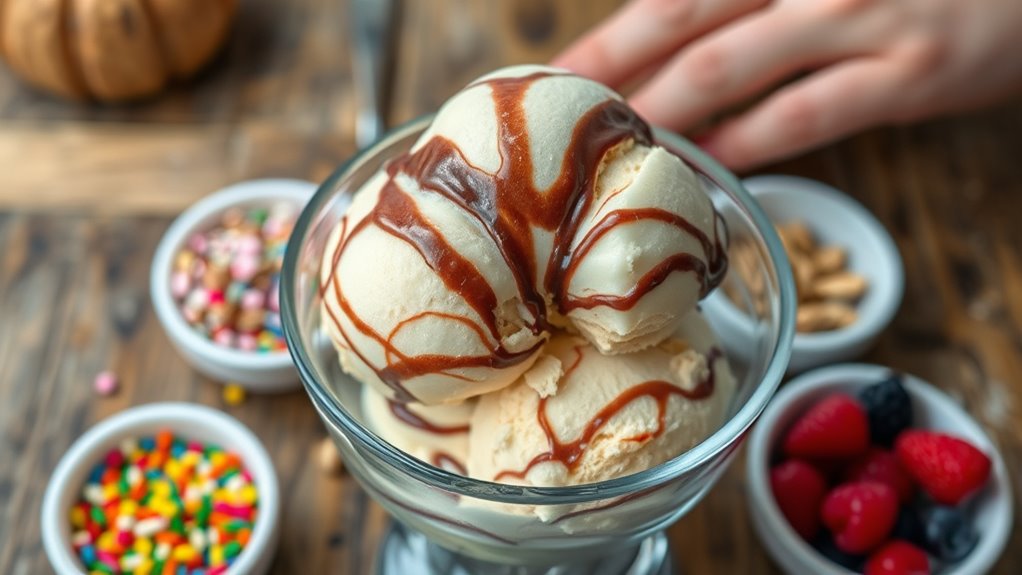Absolutely, making ice cream without a machine really works! By using simple techniques like slow freezing, regular stirring, and chilling your mixture thoroughly, you can achieve a creamy, store-quality texture at home. Using metal dishes and adding flavors like fruit purees or infusions also helps improve consistency. With a few easy steps, you’ll discover how to create delicious homemade ice cream without any fancy equipment—keep going for all the tips and tricks to perfect your process.
Key Takeaways
- Yes, homemade ice cream without a machine is achievable using manual stirring and proper freezing techniques.
- Regular stirring during freezing prevents ice crystal formation, resulting in a creamy texture.
- Using metal shallow dishes speeds up freezing and improves consistency without specialized equipment.
- Incorporating flavor infusions and controlling temperature enhances flavor and smoothness.
- With patience and proper technique, store-quality ice cream can be made at home without a machine.

Making ice cream at home without a machine is easier than you might think, and you don’t need any special equipment to get creamy, delicious results. With a few simple ingredients and some clever techniques, you can craft a treat that rivals store-bought gelato. One key to achieving that smooth, velvety texture lies in mastering gelato techniques, which emphasize slow churning and careful temperature control. While you don’t have a machine, you can still mimic these methods by regularly stirring your mixture during freezing, preventing ice crystals from forming and ensuring a creamy consistency. Incorporating flavor infusions is another way to elevate your homemade ice cream. By simmering herbs, spices, or fresh fruit in your base, you can infuse deep, complex flavors that make your ice cream stand out. The trick is to let your infusions steep long enough to develop richness but not so long that they overpower the base.
Master gelato-like ice cream at home with slow freezing and flavor infusions.
To get started, you’ll want a good base—usually a mixture of cream, milk, sugar, and egg yolks if you’re aiming for a custard-style ice cream. Once your base is prepared, add your flavor infusions. For example, steeping vanilla beans or lemon zest in warm milk allows the flavors to meld beautifully. After straining out the solids, chill the mixture thoroughly. The real magic happens during the freezing process. Pour your chilled base into a shallow dish, preferably metal, which helps it freeze faster. Every 30 minutes, take it out and give it a vigorous stir, breaking up ice crystals and incorporating air to keep the texture smooth. Repeat this process until your ice cream reaches the desired consistency. Additionally, using proper storage techniques can help maintain the quality and texture of your homemade ice cream over time. Proper storage in an airtight container prevents ice crystal growth, preserving the creamy texture longer.
Incorporating techniques to control ice crystal formation during freezing can significantly improve the final texture of your ice cream. If you want to experiment with gelato techniques, focus on reducing the amount of air incorporated, which results in a denser, richer product. Less whipping and more slow freezing help achieve that authentic gelato feel. For flavor infusions, consider adding fruit purees, extracts, or even alcohol to enhance the flavor profile. Just keep in mind that alcohol can prevent the mixture from freezing completely, so add it sparingly. Additionally, utilizing techniques to prevent ice crystal growth can help you achieve an ultra-smooth texture that rivals commercial products.
Furthermore, utilizing powerful persuasive words in your recipe descriptions or presentation can entice others to try your homemade creations and boost your confidence in improvising with different flavors. The overall goal is to create a balanced, flavorful ice cream that’s as silky as possible without a machine. In the end, making ice cream without equipment isn’t just doable—it’s fun and customizable. You control the ingredients, flavors, and texture, allowing you to create unique, high-quality frozen treats at home. With patience and a little creativity, you’ll soon find that you don’t need a fancy machine to enjoy homemade ice cream that’s just as good, if not better, than what you’d find in stores.
Frequently Asked Questions
How Long Does Homemade Ice Cream Typically Last in the Freezer?
You wonder how long homemade ice cream lasts in the freezer. Typically, proper ice cream storage keeps it good for about 2 to 4 weeks, depending on your freezer’s conditions. To maximize freezer lifespan, store it in an airtight container and minimize air exposure. After this period, the texture may suffer, and flavors can fade. Always check for ice crystals or freezer burn before enjoying your homemade treat.
Can I Add Fruit Chunks or Mix-Ins During the Freezing Process?
Think of your ice cream as a canvas, waiting for your fruit addition masterpiece. You can add fruit chunks or mix-ins during the freezing process, but timing is key—wait until the ice cream is slightly firm, not fully frozen. Gently fold in your mix-ins to avoid breaking the texture. This way, your ice cream stays creamy, and your fruit stays vibrant and delicious in every bite.
Is Homemade Ice Cream as Creamy as Store-Bought Varieties?
You wonder if homemade ice cream matches store-bought in creaminess. The texture comparison often shows homemade tends to be less smooth unless you churn it properly or add stabilizers. Flavor consistency can vary based on ingredients and freezing time, but with careful mixing and patience, you can achieve a rich, creamy result. While it might not be exactly like store-bought, homemade ice cream offers freshness and customization you can’t beat.
What Are the Best Types of Containers to Use for Freezing?
When choosing containers for freezing your homemade ice cream, opt for those with good insulation to prevent rapid temperature changes. You want a container that maintains a consistent freezer temperature and minimizes ice crystal formation, keeping your ice cream creamy. Use airtight, sturdy containers like metal or plastic with tight lids. Avoid flimsy or porous options, as they compromise insulation and may cause freezer burn, affecting texture and flavor.
Can I Make Dairy-Free or Vegan Ice Cream Without a Machine?
Yes, you can make dairy-free or vegan ice cream without a machine. You’ll want to use plant-based alternatives like coconut milk, almond milk, or cashew cream, combined with sweeteners and flavorings. Blend everything until smooth, then freeze, stirring every 30 minutes to prevent ice crystals. This method works well with dairy-free ingredients, giving you delicious, homemade vegan ice cream without needing specialized equipment.
Conclusion
Making ice cream without a machine is like crafting a cozy blanket—you can create something delicious and satisfying with a little effort. While it might take some patience and a bit of elbow grease, the reward is worth it. You get to enjoy creamy, homemade ice cream without fancy gadgets, just like a chef in your own kitchen. So go ahead, experiment, and savor the sweet taste of your own DIY frozen treat!











